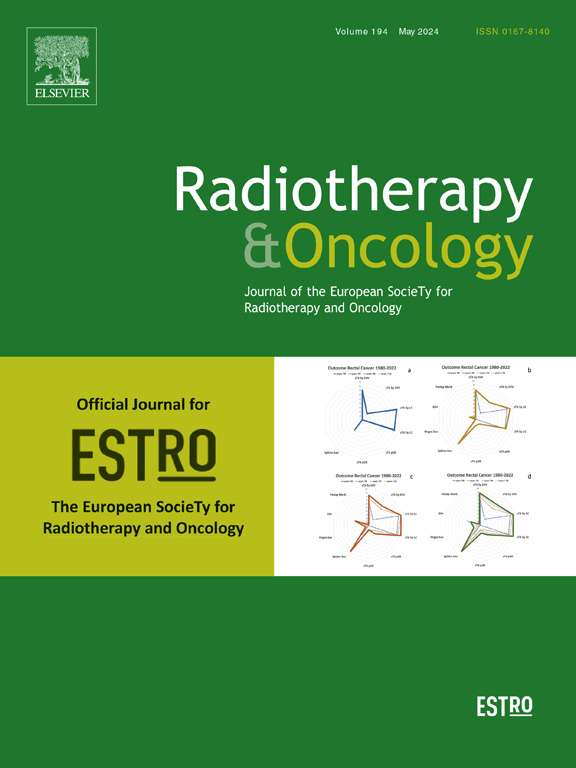Associations between dosimetry and patient-reported outcomes in oropharyngeal cancer: post hoc analysis of elective neck de-escalation trials
IF 4.9
1区 医学
Q1 ONCOLOGY
引用次数: 0
Abstract
Introduction
When using IMRT for oropharyngeal squamous cell carcinoma (OPSCC), the extent to which patient-reported outcomes (PRO) improve at progressively lower dose distributions is unclear. In this study, we evaluated the relationship between PROs and dosimetry in OPSCC patients on two elective neck irradiation (ENI) de-escalation trials.
Methods
Eligible patients in this analysis had a diagnosis of OPSCC and were treated on two ENI de-escalation trials. Contoured OARs included oral cavity (OC), floor of mouth (FoM), superior/middle constrictors (SMC), parotid glands (PG), submandibular glands (SMG), and tubarial glands (TG). OAR metrics were dichotomized at the median and in tertiles. The primary endpoints were 3- and 12-month PROs: the overall MD Anderson Dysphagia Inventory (MDADI) and Dry Mouth (DM) and Sticky Saliva (SS) scores from the EORTC HN35.
Results
The analysis includes 86 patients. The median mean doses were contralateral (CL, 15.7 Gy) and ipsilateral PG (26.3 Gy), contralateral SMG (35.3 Gy), OC (29.3 Gy), and SMC (47 Gy). OC, SMC and TG were significant predictors of 12-month MDADI, with a dose–response below the lowest tertile. Three-month DM scores were associated with OC doses, CL PG V15 and CL SMG V30, but only FoM and CL SMG V30 were predictors of 12 month DM. Oral cavity, FOM, and SMG doses were associated with 12 month SS outcomes.
Conclusions
In a cohort of patients treated with de-escalated IMRT, the critical impact of OC and SMG doses became evident. More work is needed to understand both dosimetric and non-dosimetric predictors of long-term PROs.
口咽癌剂量测定与患者报告结果之间的关系:择期颈部降级试验的事后分析
当使用IMRT治疗口咽鳞状细胞癌(OPSCC)时,患者报告的预后(PRO)在逐渐降低的剂量分布下改善的程度尚不清楚。在这项研究中,我们评估了两项选择性颈部照射(ENI)降级试验中OPSCC患者的PROs和剂量学之间的关系。方法:本分析中符合条件的患者诊断为OPSCC,并接受两项ENI降级试验的治疗。轮廓型桨包括口腔(OC)、口腔底(FoM)、上/中缢管(SMC)、腮腺(PG)、下颌下腺(SMG)和输卵管腺(TG)。OAR指标按中位数和分位数进行二分类。主要终点是3个月和12个月的PROs: MD安德森吞咽困难量表(MDADI)和EORTC HN35的口干(DM)和唾液粘稠(SS)评分。结果:共纳入86例患者。中位平均剂量为对侧(CL, 15.7 Gy)和同侧PG(26.3 Gy),对侧SMG(35.3 Gy), OC(29.3 Gy)和SMC(47 Gy)。OC、SMC和TG是12个月mddi的重要预测因子,其剂量反应低于最低分位数。三个月DM评分与OC剂量、CL PG V15和CL SMG V30相关,但只有FoM和CL SMG V30是12 个月DM的预测因子。口腔、FoM和SMG剂量与12 个月SS结果相关。结论:在一组接受降级IMRT治疗的患者中,OC和SMG剂量的关键影响变得明显。需要做更多的工作来了解剂量学和非剂量学对长期PROs的预测。
本文章由计算机程序翻译,如有差异,请以英文原文为准。
求助全文
约1分钟内获得全文
求助全文
来源期刊

Radiotherapy and Oncology
医学-核医学
CiteScore
10.30
自引率
10.50%
发文量
2445
审稿时长
45 days
期刊介绍:
Radiotherapy and Oncology publishes papers describing original research as well as review articles. It covers areas of interest relating to radiation oncology. This includes: clinical radiotherapy, combined modality treatment, translational studies, epidemiological outcomes, imaging, dosimetry, and radiation therapy planning, experimental work in radiobiology, chemobiology, hyperthermia and tumour biology, as well as data science in radiation oncology and physics aspects relevant to oncology.Papers on more general aspects of interest to the radiation oncologist including chemotherapy, surgery and immunology are also published.
 求助内容:
求助内容: 应助结果提醒方式:
应助结果提醒方式:


